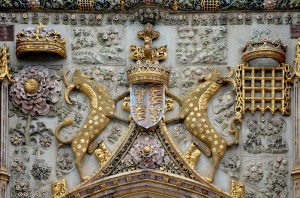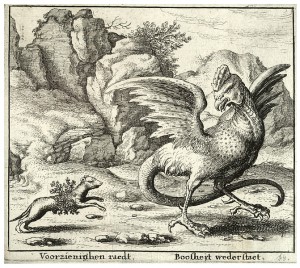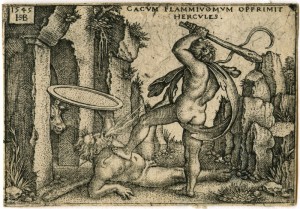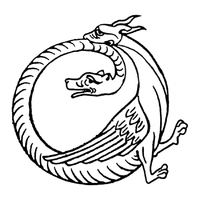The Unofficial Ancient Roman Monster Survival Guide Posted by Brittany Britanniae on Oct 22, 2013 in Latin Language, Roman culture
Welcome to the Unofficial Ancient Roman Monster Guide!
While, everyone knows about centaurs, harpies, cyclopes, mermaids, sirens, the chimera, hydra, giants, and et cetera; this guide’s goal is expose the truth of the monsters that hide under our very noses! The following monsters are very dangerous and should NOT be approached under any circumstance. Most of these creatures and monsters eat people, so if you seen one please contact your local animal control or classicist.
Number 1
Monster: Yale or Eale which means “To move back” – perhaps in reference to its horns
First Spotting: Ethiopia
Form: Antelope or Goat like creature that is the size of a hippopotamus, with an elephant’s tail, of a black or tawny color, with the jaws of a boar and movable horns
Food: People and Large Animals
How it attacks: Presumably, it must ram its prey with its moveable horns and tusks.
Latest Spotting: A popular emblem in medieval times for royal banners, the yale or eale has found its way to Yale University’s banners and perhaps into the basements of the campus itself.
Sources: Ancient Authors as seen here.
Number 2
Monster: Manticore which means “Man-Eater”
First Spotting: Persia
Form: Body of a red lion, a human head, with a trumpet-like voice. Sometimes it is seen with horns or wings.
Food: People and Large Animals
How it attacks: Its tail may either be a in the form of a dragon or scorpion which shoots poisonous spines that paralyze and kill its victims.
Latest Spotting: Commonly, the manticore has been spotted in archaic themed video games such as God of War and Age of Mythology. Recently, one manticore was seen debuting in his first film: Percy Jackson and Sea of Monsters. He sadly did not survive to make a sequel.
Sources: Greek and Roman Authors as seen here.
Number 3
Monster: Basilisk or Regulus which means “Little King”
First Spotting: Cyrene, Libya
Form: A small snake “not longer than twelve fingers” with a crown shaped crest on its head. At times, the basilisk is seen with the head of a cockatrice due to its odd birthing ritual.
Food: Anything
How it attacks: By bite or gaze; it is extremely poisonous and lethal.
Latest Spotting: A large basilisk was spotted in the early Harry Potter film franchise living in Hogwart’s pipes. Rowling also mentions its presence in her own monster guide book: read it here. Its eggs are a unique and rare item that players attempt to find in the latest video game: Final Fantasy XIV.
Sources: Pliny the Elder’s Natural History as seen here.
Number 4
Monster: Cacus which means “the evil or bad one”
Origins: Rome; Aventine Hill
Form: A giant who breathes fire and is the son of Vulcan
Food: Human flesh, but not their heads. He would nails the heads of his victims outside his cave.
How it attacks: It attacks and kills its enemies and prey by breathing fire and smoke onto them.
Latest Spotting: While Cacus has not been seen since Hercules apparently strangled him to death; The Percy Jackson series makes mention of him ;suggesting that he did not die or has a brother.
Sources: Roman Authors as seen here.
Number 5
Monster: Amphisbaena (means “goes both ways”) or Mother of Ants
First Spotting: Libyan Desert sprouting from the blood of Medusa’s head, and later by Cato’s army.
Form: A two headed serpent, whose tail has the second head.
Food: Anything Living or Dead
How it attacks: It has a poisonous bite.
Latest Spotting: They appear to have been a popular inspiration within Insular art during the Medieval Ages; however they are said now to be “summoned” by a Dungeon Master when playing the game Dungeons and Dragons.
Sources: Pliny the Elder’s Natural History as seen here.
Safety and Caution Procedures
Now, while most of these monsters will leave you alone if you leave them alone; if you happen to run into one of these creatures you must :
I. Run as fast you can and avoid eye contact
or
II. Summon your inner hero strength and fighting skills
or
III. Pray to the Roman Gods
or
IV. Rent a Pegasus and fly away.
We sincerely hope that you enjoyed this guide and you look for our next issue on: How to survive the uses of the Ablative.
DISCLAIMER: The Unofficial Ancient Roman Monster Survival Guide is neither responsible for any harm or deaths that occur as a result of enthusiast attempting to capture or tame these creatures.

Build vocabulary, practice pronunciation, and more with Transparent Language Online. Available anytime, anywhere, on any device.
About the Author: Brittany Britanniae
Hello There! Please feel free to ask me anything about Latin Grammar, Syntax, or the Ancient World.







